Nike is one of the most well-known athletics brands on the planet.
And it was founded 55 years ago, in 1964. Named after the winged goddess of victory in Greek mythology, Nike is now one of the world’s richest and most affluent companies, placing 90th on the Fortune 500 list and generating about 36 billion dollars in revenue every year.
But how does Nike — one of the most lucrative companies on the planet — use email marketing to build long-lasting relationships, sell, and keep their customers happy?
Well, we signed-up to Nike’s email list as a brand-new subscriber and have paid close attention to how they’re communicating, what they’re sending, and why they might be sending it. Here’s what we’ve received and learned along the way after 3 months of being subscribed to Nike’s email list.
Nike’s Welcome Email
After we signed up, we received the following welcome email within minutes.

Some welcome emails just offer a friendly greeting. But Nike — perhaps staying true to their infamous “Just do it” slogan — strikes while the iron is hot. Right from the gate, they invite you to join NikePlus, their almost gamified member platform with exercise and shopping apps, access to Nike experts who can help you pick the perfect pair of sneakers, and other member-exclusive perks.
At the bottom, they have a CTA to find a brick-and-mortar store near the subscriber’s location, likely to help people who would rather shop in-person rather than online.
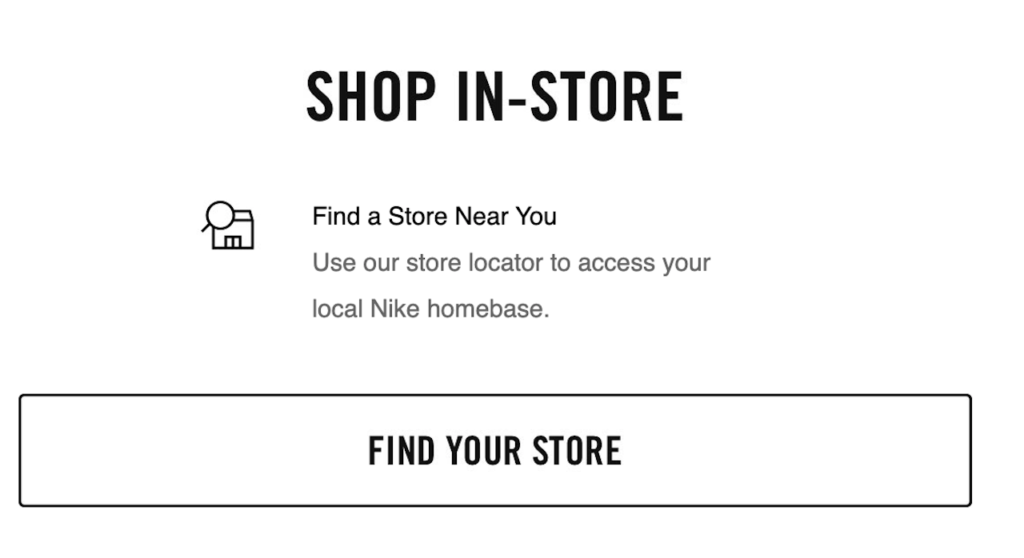
Nike’s NikePlus Welcome Email
In the spirit of learning about Nike’s emails, we took their bidding and signed up for a NikePlus membership. Not long after, we received this email.
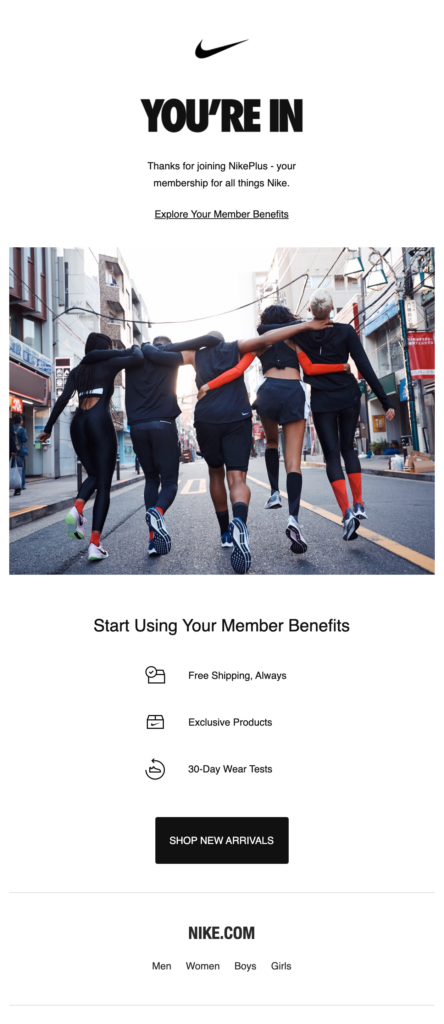
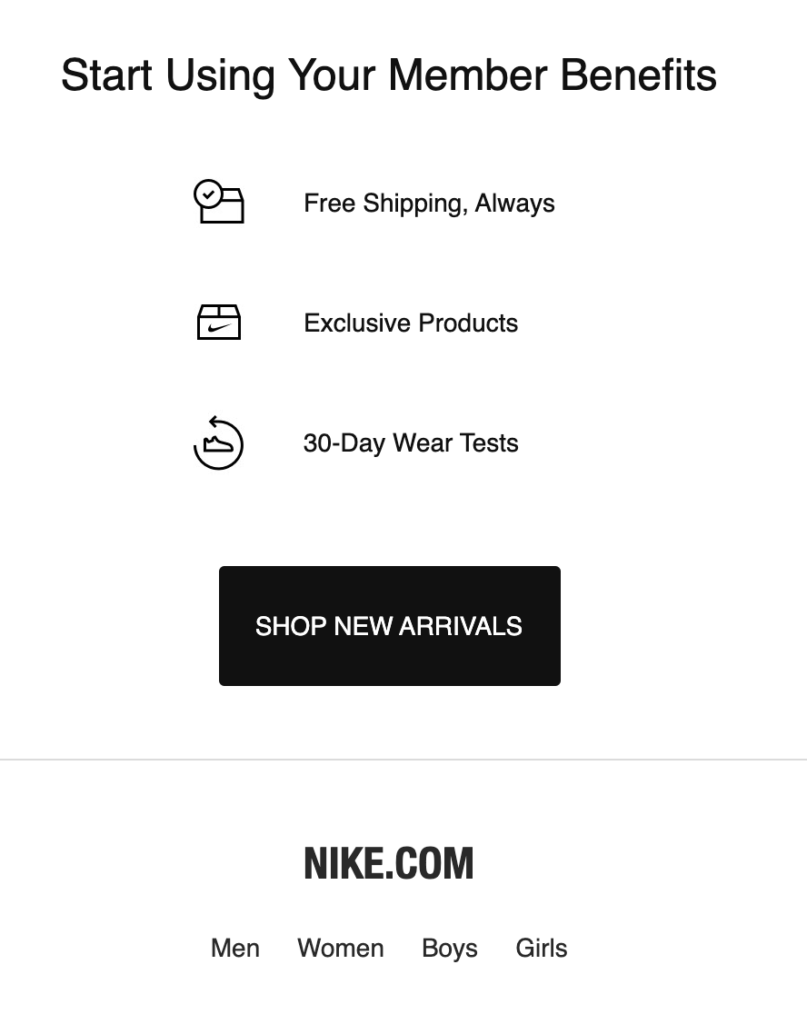
Now, there’s one thing we want to point out here that you’ll see in every single one of Nike’s emails: the bottom, under “NIKE.COM” with the clickable list of “Men Women Boys Girls” options.

Why is that there?
Well, it’s probably so that if a subscriber sees a Nike email and thinks to themselves, “I need to buy something for my wife for her birthday!” or “I really need a new pair of sneakers” or something similar, they have immediate access to shop, browse, and buy. It’s clear from Nike’s email campaigns — and you’ll notice this more as we explore — that they do not want to get in the way of someone’s spontaneous or pre-planned desire to purchase. In fact, many of their emails seem to be trying to trigger these spontaneous moments.
On another note, you may have noticed the header photo continuity between the welcome email we received and the NikePlus welcome email. Here they are again side by side.

The first email shows a group of kids posing and having fun in almost childish athletic wear, while the second photo is a more serious image of adults walking down the street together in much nicer athletic clothing. It’s almost as if the same kids grew up, from the first photo to the second, which is indicative of what Nike likely wants you to feel about your experience at this point — that now you have access to all the best, top-notch gear they have to offer.
These photos also work to create a consistent image that help subscribers quickly identify the Nike brand and even create associations between Nike products, activity, team-work, and friendship — which are trends we’ll see more of in Nike’s future emails.
(Remember, people don’t buy what you do, they buy why you do it, according to Simon Sinek)
Now, we’re not sure what happened here, but a few days after we signed up for NikePlus, we received an email trying to get us to sign up for NikePlus — it probably sent by mistake and is one of their emails used to prompt people to take the leap we’d already taken. Here is that email.

Notice again, the header image for the email. It’s very similar to the other images they’ve used in their emails — athletic friends having fun and playing games together.
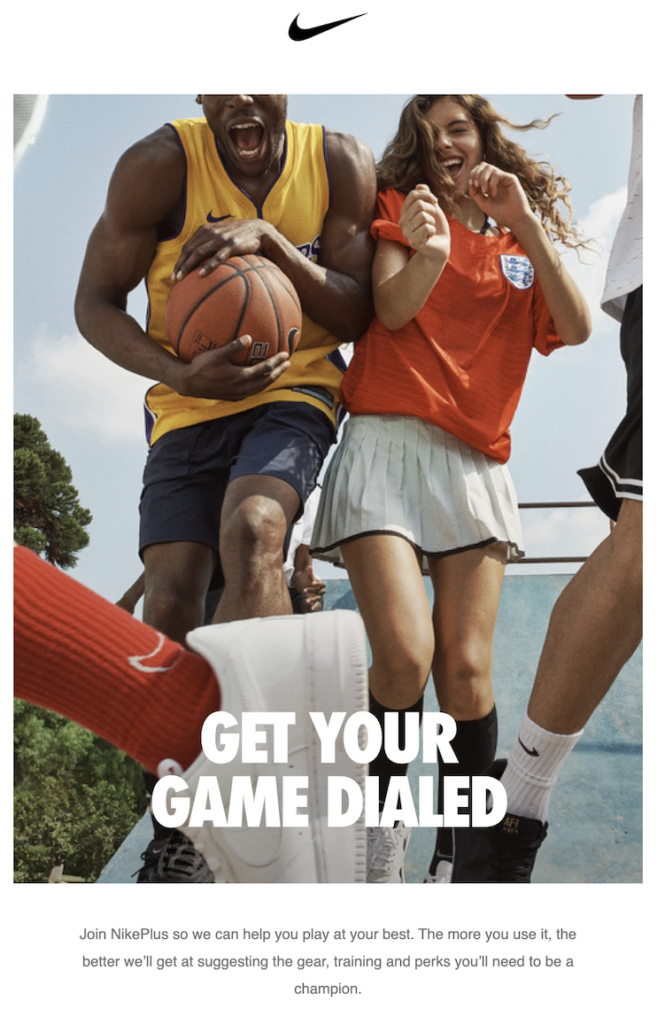
Nike, after all, sells a lifestyle to its customers — a progressive, active lifestyle — and these images help to reinforce that brand identity.
They then list off the buying benefits of signing up with NikePlus and the apps you can download to “Go all in.”

Why?
The more that they can get you — their subscriber — to associate with the Nike brand identity and way of life, the more dedicated you’ll be and the more products you’ll buy. Which is why they keep encouraging their subscribers to download their apps, find a nearby store, and signup with NikePlus — they’re trying to make the new subscriber a part of their inner tribe.
For good reason, too. The inner tribe of any business is where the magic happens. 80% of profits come from just 20% of customers and selling to an existing customer is 60% easier than selling to a new customer.
Nike’s Abandoned Cart Email
Next, we wanted to see what Nike would do if we put a pair of sneakers in our cart and then abandoned them.
And while some companies trigger their abandoned cart email within the hour, we didn’t receive Nike’s until a few days later. When we did, here is what it looked like.

As with most of Nike’s email campaigns, there’s a lot going on here. You get the sense that they want you to get a little bit lost in the buying experience, which can certainly be a good thing for big ecommerce brands that want their customers to keep coming back for more.
One thing that is unique to this email, though, is “Free Shipping” text at the top. That, of course, is fitting for an email which is reminding you about products in your digital cart and trying to prompt you to finish your purchase.
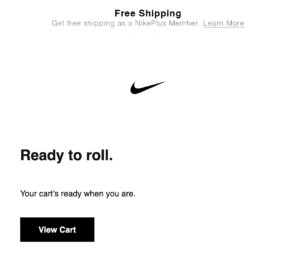
Next, they show you an image of the product in your cart and the price of that product, with a CTA to “View Cart.”
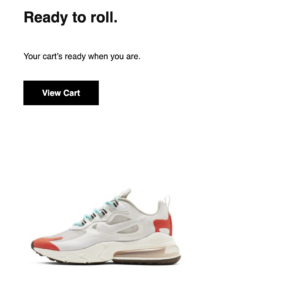
But they don’t stop there.
For subscribers who aren’t sure that the product is quite right for them, they offer free guidance from one of their Nike Experts (which is just their glorified sales team) — buying clothing online can be a little nerve-wracking and this is the perfect way to soothe that fear.

And they even offer 30-day free returns so that if you order something you don’t like, you can just return it — no big deal — again, soothing the common fear of purchasing high-ticket clothing online.
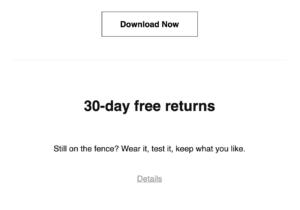
They end the email with a few similar items, encouraging subscribers who’ve lost interest in the original product to purchase something else.
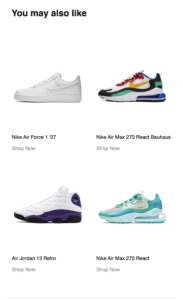
When you think about it, this email nails all the points of an effective sales page.
- It reminds the subscriber of what they’re interested in.
- It soothes every possible objection.
- And it offers alternatives if the original product is no longer a good fit.
The first goal is to get the subscriber to finish their purchase, but the just-as-important second goal is to keep the buying thought-process going even if the subscriber doesn’t purchase, which is why Nike finishes the email with other recommended products.
Nike’s Weekly Email Cadence
There are many online debates about how many emails a business should per week. Some marketers believe that daily or even multi-daily is the way to go, keeping you constantly top-of-mind with your subscribers. Others believe that emailing once per week is ideal, as it keeps you communicating with your audience, but in a non-invasive way (rather than flooding your subscribers’ inboxes).
From what we can tell, however (with the exception of behaviorally triggered emails) Nike seems to have a monthly cadence rather than a weekly cadence. Four emails send on the same day every month — the 1st, 5th, 13th, and 28th — making their cadence not quite weekly but not quite bi-weekly (there’s a gap week in between the 13th and 28th and two emails send on the first week).
We received Nike’s first “weekly” email on Sunday, July 28th, and then the next one on Thursday, August 1st, and another on Monday, August 5th, followed by emails on August 13th and 28th, and September 1st and 5th.
But keep in mind — this is our experience as a subscriber who hasn’t yet purchased anything and only opens some of their emails. It’s possible that Nike has a different email cadence for different interaction-based segments of subscribers. It’s also possible that each subscriber is on their own timeline based on when they signed up.
Whatever the case, Nike’s emailing tendencies are difficult to predict — and they might be on a monthly rhythm rather than a weekly rhythm — an unusual email marketing practice that might be worth your time to try. There certainly can be value in keeping your email timing less rigid and more unexpected — this can work to create a sense of humanity and personality rather than redundancy. And Nike seems to be banking on the pleasure that an unexpected and sort-of randomized emailing cadence can create for their subscribers.
It’s hard to blame them. Psychologically speaking, when humans are surprised by something, we freeze for 1/25th of a second and pay more attention to what’s going on. Here’s how Tania Luna, author and TED-talk speaker, explains the psychology of surprise:
“It’s a strong neuro alert that tells us that something is important about this moment and we have to pay attention… Our cognitive resources are basically hijacked and pulled into the moment. That’s one of the things that’s really uncomfortable for some people, but also exciting for some people because your attention is completely in the moment.”
Is it possible that Nike uses that same psychological tendency in their email cadence to consistently surprise and delight their audience? It’s a small thing, but it’s certainly possible.
Now, let me show you the emails that we received. Here’s the first one (we’re not counting any triggered emails here, just broadcasts) that we received on August 1st.

As is true for most of Nike’s emails, this first message operates much like a strategically written and designed sales page. They give you plenty of different products to consider purchasing, in hopes that something will catch your eye and you’ll click to their website (as indicated by the copy at the top that says, “These are the four things flying off our shelves. And there’s more where that came from.”).

Then they remind you that you have free access to Nike experts (basically, their sales team) that can help you find the perfect product. And they finish with a pinch of risk-reversal, reminding you that you can return anything you order within 30 days for any reason whatsoever.
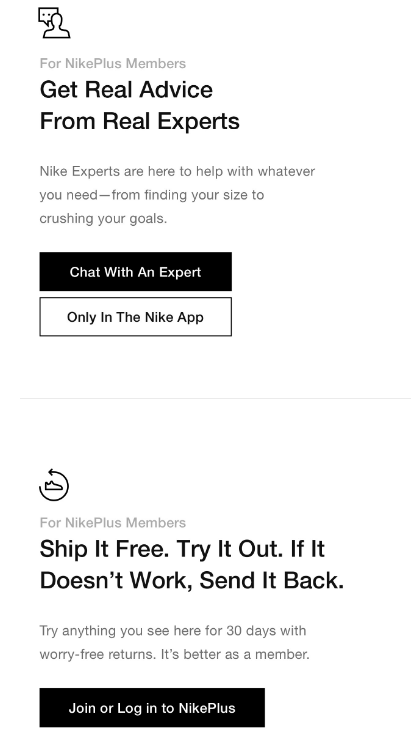
That’s a great structure for any email that’s trying to sell consumer products.
The second email we received was a personalized list of recommended products.

This email is at least semi-personalized. All we had looked at on their website was sneakers, so it makes sense that we’d receive an email full of other recommended sneakers for me to check out.
You’ll also notice that Nike is fond of including a “You may also like” section in their emails.
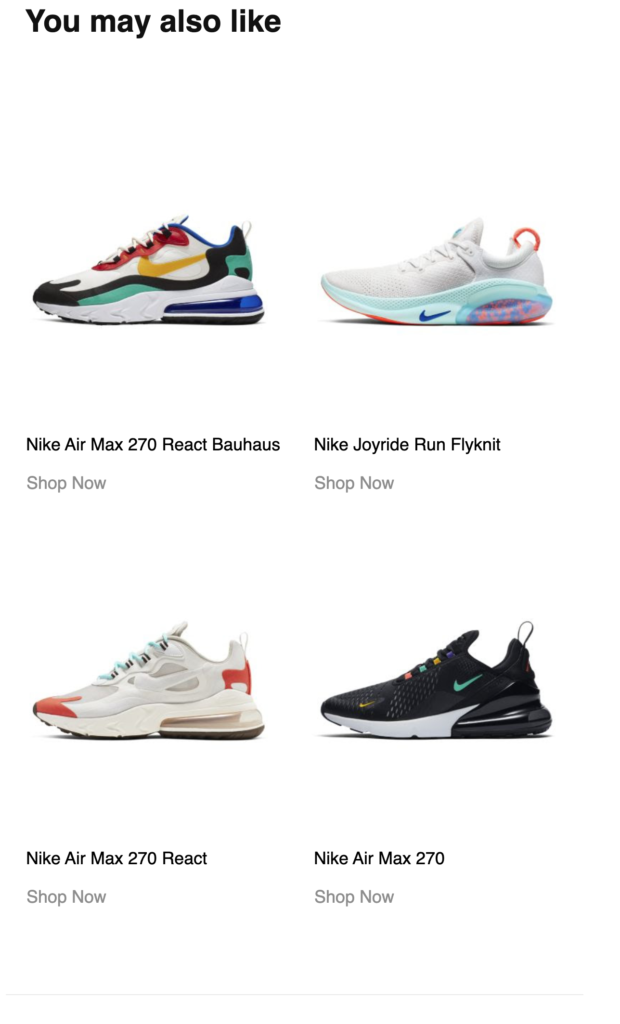
But why is that there? Why not just show the first set of recommended products and be done with it? We can only conjecture, of course, but it’s probably because they want you to get lost in your shopping experience. Like consumers at a shopping mall, they want you to browse and connect with their brand and have the full buying experience.
Why?
Because browsing encourages impulsive buying. The more products that a person browses through, the more likely they are to make an impulsive purchase, especially in the world of B2C. In fact, of the millions of Americans who shopped online in 2018, 44% reportedly made an impulse purchase at one point or another.
Again, Nike tries to push its subscribers toward a shopping experience that keeps them browsing and buying, which, of course, is good for business.
The other emails we received are quite similar to the two I’ve already mentioned and it would be redundant to mention them here.
Nike’s Back-In-Stock Email
What happens if someone goes to your website, finds a product that they love, and attempt to purchase… but the product is out of stock?
Is that the end of the story?
This question applies to service offers and info-products as well. When someone tries to buy, but they can’t, for whatever reason, how does your website deal with that?
Nike, as any smart ecommerce store, encourages the browser to enter their email address (which is a way to collect leads) in order to receive a back-in-stock notification. When we opted-in to one of these back-in-stock notifications, this is the email we received a few days later…

This email is appropriately centered around reminding the receiver that the item they were interested in is back in stock. They even include a “Shop” link that leads directly to that product’s page.
And most back-in-stock emails we’ve seen stop there. But not Nike — Nike also lists a few other products that the person might be interested in.
But doesn’t that take away from the main call-to-action? you’re wondering to yourself.
Well, in some cases, it might. But in Nike’s case, it doesn’t.
Think about it. Nike runs a business where its customers like to shop and explore and find the perfect pair of sneakers for what they’re trying to do. And Nike takes every opportunity to encourage their customers to shop because the more that people explore, the more that they sell themselves on certain products.
That isn’t the case for all businesses of course. For some businesses, it’s far better to laser-focus on just one product or service.
You’ll have to determine for yourself how your customers like to shop and whether you should encourage or discourage further product browsing.
Nike’s Customer Service Feedback Email
Every successful entrepreneur or business person knows the importance of collecting feedback from your target market, even if you’re company is thriving and growing.
Getting feedback on your products and on your customer service creates accountability and offers your customers an important opportunity to express themselves (whether positively or negatively).
You can then apply this feedback to your business and take any necessary actions.
After contacting customer service regarding the recent order, we received this email from Nike…

We love the simplicity of this email.
First of all, they encourage the person to provide honest feedback by saying, “Your feedback helps us get better at what we do, every day.”
Then they’re straightforward about how long the survey is going to take (which is important for people who have busy schedules).
Is your business collecting feedback from your customers? Using an email like this (not just for customer service, but also for your products) represents of gold-mine of learning and iterating potential.
Remember, the businesses that grow the fastest learn the fastest.
Nike’s Post-Purchase Emails
The next obvious step was to find out what Nike’s email campaigns look like when we purchase something. Thus far, we had played around on their website, abandoned our cart, and monitored their emails, but now it was time to actually pull out our wallet and buy some sneakers.
So we did.
The first email we received looked like this.
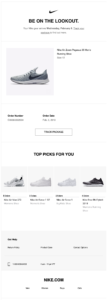
For convenience, they provided us with the date that we can expect the package to arrive (much appreciated when you’re on the consumer end of things). Then they also gave us the order number and the ability to track the package — all standard stuff for a digital e-commerce receipt.
But what’s interesting is that they also include a “Top Picks For You” section near the bottom of the email.
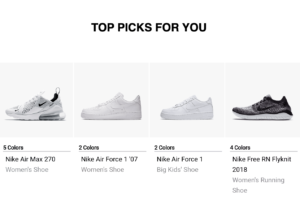
Why do they include that?
Well, it’s probably because they know that the average email receipt gets a 70% open rate, which is at least 4 times higher than the cross-industry average.
Crazy, huh?
If you’re not including some sort of up-sell or subtle product promotion (remember, the subscriber relationship comes first) within your receipts, then you are probably missing out on revenue generation potential for your business.
Consider trying a “You might also like” or “Other products we think you’ll love” section in your receipt emails and see what happens.
As for triggered emails, something interesting happened when we went to check the status of our order in Nike’s app. We received this email…

The subject line for this email was “Looking for your Nike order?“
This illustrates several important email marketing tactics.
The most obvious benefit of this Nike email is that it probably cuts down on support tickets.
But second, this email was triggered by the activity that occurred in Nike’s mobile app. Allowing channels (email, push notifications, SMS, etc) to interact with each other creates a more seamless and personal experience for users. This is known as omnichannel marketing.

Because of the remarkable experience that omnichannel marketing creates, businesses with omnichannel marketing strategies achieve 91% greater year-over-year customer retention rates than those that don’t.
(Adobe and Braze both have omnichannel marketing solutions)
And finally, this email reveals the power of automation and segmentation. The most successful email marketers use those two tactics to craft triggered emails that help customers, reduce churn, and encourage conversion.
By automatically triggering this email when a customer searches for the status of their order in the Nike app, they’ve taken one small step toward all three of those goals.
Download the visualized teardown

Download the Visualised Teardown
Enter your email address to download our one-page visualisation.
We respect your privacy. Unsubscribe at any time.
Conclusion
So what do we learn from Nike’s email campaigns?
First and foremost, we learn that if you’re running a B2C business, it might not be such a bad idea to get the subscriber a little lost in the online shopping experience. Consumers like to feel as though they are making the buying decision for themselves, as though they are the ones who found a great deal on that pair of sneakers or on those leggings. And the more perceived control you give them, the more they’ll pay you.
We also learn that consistent branding is immensely valuable for creating a recognizable brand experience, that risk-reversal can help make sales, that a good sales email should operate similar to a sales page, and that there might be something powerful to leveraging an inconsistent email cadence which surprises and delights your subscribers.
discuss on twitter